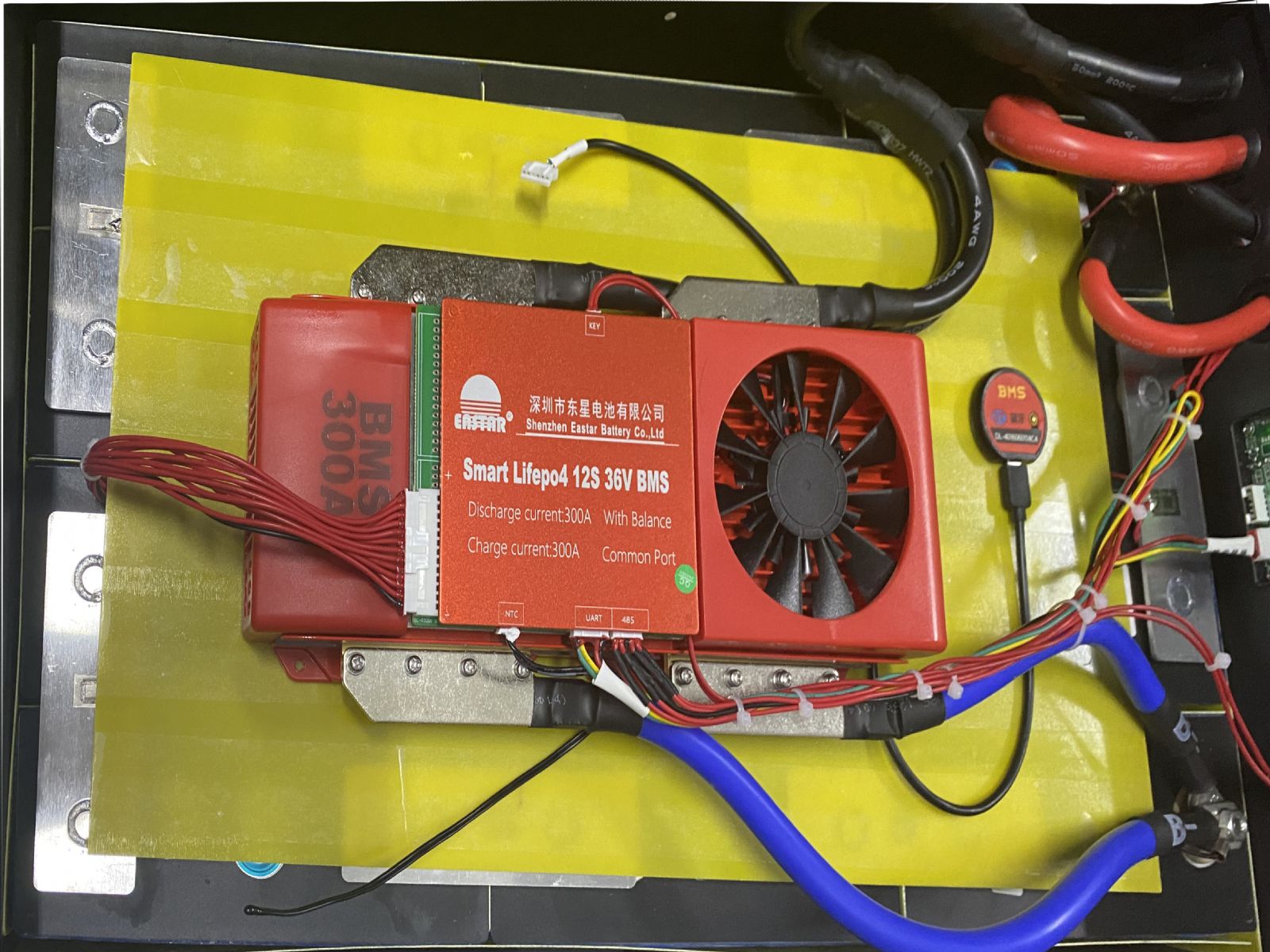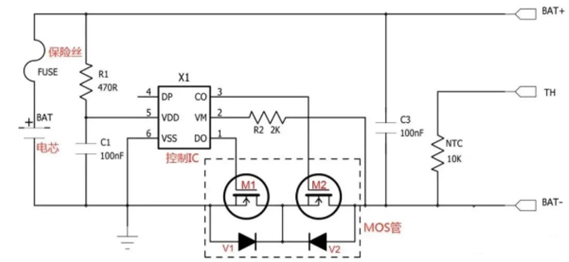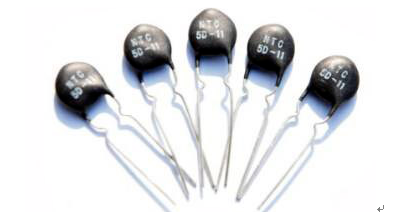Pop questionsYou are here: Home - Technical Support - Pop questions
What is the function of BMS ?
Date: 2022-11-24 11:36:58Downloads: 441
Lithium battery materials have certain characteristics, so that they can not be overcharged, overdischarged, overcurrent, short circuit and ultra-high and low temperature charge and discharge, so lithium battery packs will always be accompanied by BMS, BMS full name: Battery Management System

1. BMS function
four main features:
(1) Detect and measure the status of the battery, This is the basic function of BMS, including the measurement and calculation of some index parameters, including voltage, current, temperature, electricity, SOC (state of charge), SOH (state of health), SOP (state of power), SOE (state of energy).
SOC can be popularly understood as how much power is left in the battery, and its value is between 0-100%, which is the most important parameter in BMS; SOH refers to the state of health of the battery, which is the ratio of the actual capacity of the current battery to the rated capacity, and when the SOH is less than 80%, the battery cannot be used in the power environment.
(2) Warning and protection
When the battery is in an abnormal state, BMS can alarm the platform, protect the battery and take corresponding treatment, and at the same time, send the abnormal alarm information to the monitoring and management platform and generate different levels of alarm information.
For example, when the temperature is overheated, the BMS will directly disconnect the charge and discharge circuit to protect against overheating and issue an alarm to the background.Lithium batteries mainly issue alarms for the following problems:
Overcharge: single cell overvoltage, total voltage overvoltage, charging overcurrent;
Overdischarge: single cell undervoltage, total voltage undervoltage, discharge overcurrent;
Temperature: the cell temperature is too high, the ambient temperature is too high, the MOS temperature is too high, the cell temperature is too low, the ambient temperature is too low;
Status: flooded, collision, inverted, etc.
(3) Balanced management
From the production point of view, each cell has its own life cycle and characteristics, there are no identical two batteries, due to the inconsistency of separator, cathode, anode and other materials, the capacity of different batteries can not be completely consistent, for example, if we assemble a 48V/20AH battery pack, the voltage difference of each cell, internal resistance, etc., there will be differences.
In the process of battery charging and discharging, the process of electrochemical reaction can never be consistent. Even if the same battery pack is the same, the battery charge and discharge amount will be different due to different temperature and bump degree, resulting in inconsistent cell capacity.
Therefore, the battery needs to be both passive and actively balanced. That is, set a pair of start and end balance values: for example, in a group of batteries, the difference between the voltage extremum of a single cell and the average value of this set of voltages reaches 50mV, start work, and end work at 5mV.
(4) Communication and positioning
The BMS has a separate communication module, which is responsible for data transmission and battery positioning, which can transmit the relevant data sensed and measured to the operation management platform in real time.
Second, the working principle of BMS protection
BMS includes control ICs, MOS switches, fuses Fuse, NTC thermistors, TVS transient voltage suppressors, capacitors and memory. Its specific form is shown in the figure:

In the figure above, the control IC protects the circuit by controlling the MOS switch to enable and disable the circuit, and FUSE realizes secondary protection on the basis of this. TH is temperature detection, and the interior is a 10K NTC; NTC mainly realizes temperature detection; TVS mainly suppresses surges.
(1) Primary protection circuit
Control IC The control IC above monitors the battery voltage and loop current and controls the switches of the two MOS. Control IC can be divided into AFE and MCU:
Active Front End (AFE) is a battery sampling chip used to collect voltage and current.
MCU (Microcontroller Unit) mainly calculates and controls the information collected by AFE.
The relationship between the two is shown in the figure:

1.AFE
AFE is generally a 6-pin chip, CO, DO, VDD, VSS, DP and VM. The brief introduction is as follows:
CO: charge output (charge control);
DO: discharge output;
VDD: Supply voltage, also known as output voltage, is the highest voltage;
VSS: reference voltage, where the voltage is lowest;
VM: Monitors the voltage at both ends of the MOS.
When BMS is normal, the level of CO, DO and VDD is high, and the level of VSS and VM is low. When any parameter of VDD, VSS and VM changes, the level of CO or DO will change.
2. MCU
MCU refers to the micro control unit, also known as the single chip microcomputer, with high performance, low power consumption, programmable, high flexibility. It is widely used in consumer electronics, automobile, industry, communication, computing, home appliances, medical equipment and other fields.
In BMS, the MCU is the brain, capturing all data from sensors via its peripherals and processing the data to make appropriate decisions based on the battery pack's profile.
MCU chip processes the information collected by AFE chip and plays the role of calculation (such as SOC, SOP, etc.) and control (MOS off, on-off, etc.). Therefore, battery management system has high requirements on MCU chip performance. AFE and MCU protect the circuit by controlling MOS.
3.MOS
MOS stands for Metal-Oxide-Semiconductor Field-Effect Transistor, which acts as a switch in the circuit, controlling the on-off and off-off of the charging and discharge circuits, respectively.
Its conduction impedance is very small, so its conduction resistance has little effect on the performance of the circuit. Normally, the consumption current of the protection circuit is μA, usually less than 7μA.
4. Implementation of BMS primary protection: control IC and MOS linkage
If the lithium battery is over-charged, over-discharged or over-current, it will lead to chemical side reactions in the battery, which will seriously affect the performance and service life of the battery, and may produce a large amount of gas, so that the internal pressure of the battery increases rapidly, and finally lead to the opening of the pressure relief valve, electrolyte ejections thermal control.
(2) Two-stage protection circuit: three-end Fuse
For security reasons, a secondary protection mechanism is still needed. At the current stage, REP (Resistor Embedded Protector) is a relatively high application, while three-end Fuse is more cost-effective.

When the current is too high, Fuse works in the same way as ordinary fuses and will break. When MOS runs abnormally, the three fuses of main control will be actively fused.
This safety protection mechanism has the advantages of low power consumption, fast reaction speed and good protection effect. At present, it has been widely used in electric vehicles, mobile phones and other equipment.
(3) Three-level protection circuit: NTC and TVS
1.NTC thermistor
Thermistor, as its name implies, is extremely sensitive to heat. It is a kind of variable resistance, mainly divided into PTC and NTC two kinds.
PTC (Positive Temperature Coefficient thermistor) : The higher the temperature, the greater the resistance. PTC is mainly used in products such as mosquito killer and air heater.
Contrary to PTC, NTC (Negative Temperature Coefficient thermistor) is mainly used as a resistance temperature sensor and current limiting device because the higher the temperature is, the lower the resistance coefficient is.

BMS of lithium batteries generally use NTC, which consumes less power, has high accuracy and rapid response, and has three main functions.
(1) Temperature measurement
Using the characteristics of the resistance, the following three temperature categories can be measured:
Cell temperature: Placing NTC thermistor between cells to measure cell temperature requires consideration of the number of cells covered by each NTC.
Power temperature: Placing NTC thermistor between MOS to measure power temperature requires that NTC be in close contact with MOS devices during installation.
Ambient temperature: Place the NTC thermistor on the BMS board to measure the ambient temperature. The NTC thermistor must be installed far away from the power component.
(2) Temperature compensation
The resistance of most components will increase with the rise of temperature. At this time, NTC should be used for compensation to offset the error caused by temperature.
(3) Inhibit inrush current
electrical surge, also known as surge, is the peak value of the instant beyond the stable value, including surge voltage and surge current.
The electronic circuit will produce large surge current when it is started up, which is easy to cause damage to the components. Using NTC can prevent this situation and ensure the normal operation of the circuit. TVS is used for surge protection.
2.TVS transient voltage suppressor
Transient Voltage Suppressors (TVS) provide a transient voltage suppressor with high response speed and are suitable for port protection. The specific execution is as follows:


